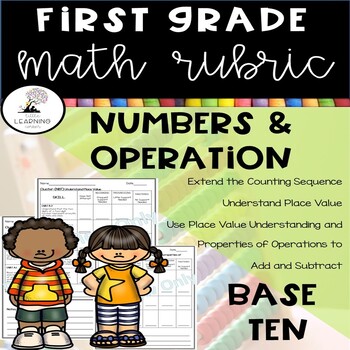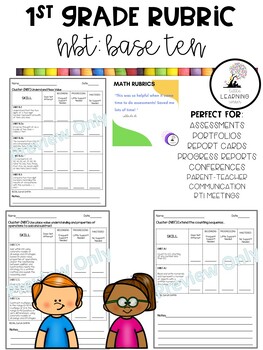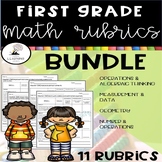First Grade Math Rubric | Number and Operations Base Ten Assessments
Little Learning Corner
4.5k Followers
Grade Levels
1st, Homeschool
Subjects
Resource Type
Standards
CCSS1.NBT.A.1
CCSS1.NBT.B.2
CCSS1.NBT.B.2a
CCSS1.NBT.B.2b
CCSS1.NBT.B.2c
Formats Included
- PDF
Pages
5 pages
Little Learning Corner
4.5k Followers
Also included in
- BUNDLE of First grade rubrics for the Common Core Math Standards. Record your students ability range for all domains and clusters for skills in Operations and Algebraic Thinking, Number and Operations in Base Ten, Measurement and data, and Geometry. Printable and ready to be copied for student recorPrice $6.97Original Price $10.00Save $3.03
Description
First Grade rubric or assessment tool for the Common Core Math Standards.
This rubric is for the Number and Operations - Base Ten domain
The skills include:
Extend the Counting Sequence
Understand Place Value
Use place value understanding and properties of operations to add and subtract
CONTENTS
1 Rubric for Extending the Counting Sequence
1 Rubric for Understanding Place Value
1 Rubric for Using place value understanding and properties of operations to add and subtract.
Great tool to record students progress, add to progress reports or report cards. Use during observation in centers, activities, or after completing formal assessments. Copy and share with parents and keep in student portfolio.
You May Also Be Interested In:
Total Pages
5 pages
Answer Key
N/A
Teaching Duration
N/A
Report this resource to TPT
Reported resources will be reviewed by our team. Report this resource to let us know if this resource violates TPT’s content guidelines.
Standards
to see state-specific standards (only available in the US).
CCSS1.NBT.A.1
Count to 120, starting at any number less than 120. In this range, read and write numerals and represent a number of objects with a written numeral.
CCSS1.NBT.B.2
Understand that the two digits of a two-digit number represent amounts of tens and ones. Understand the following as special cases:
CCSS1.NBT.B.2a
10 can be thought of as a bundle of ten ones - called a “ten.”
CCSS1.NBT.B.2b
The numbers from 11 to 19 are composed of a ten and one, two, three, four, five, six, seven, eight, or nine ones.
CCSS1.NBT.B.2c
The numbers 10, 20, 30, 40, 50, 60, 70, 80, 90 refer to one, two, three, four, five, six, seven, eight, or nine tens (and 0 ones).






